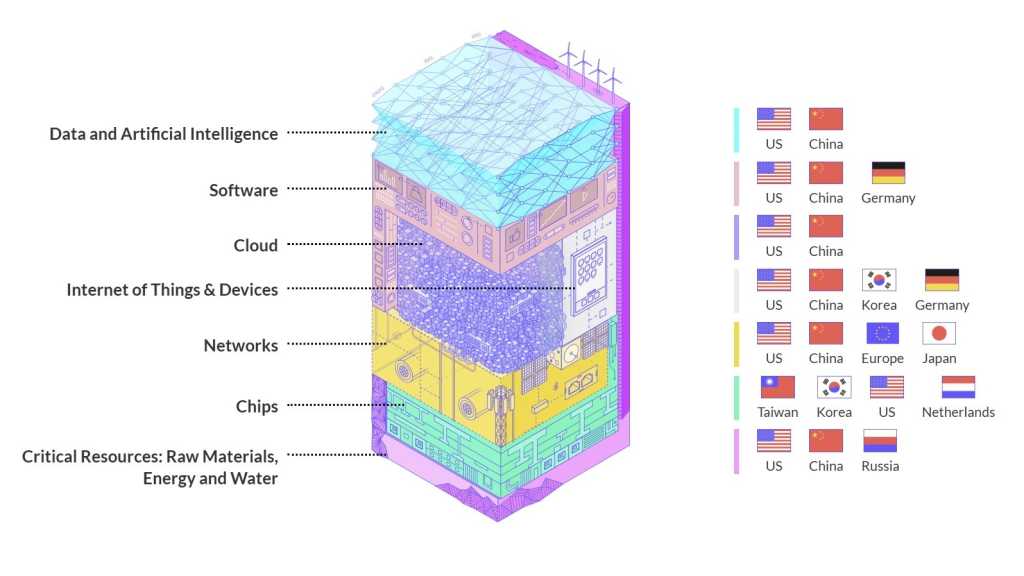Just how dangerous it is when ideological interests clash with technological power has become clear with the inauguration of US President Donald Trump. Within a very short space of time, Trump not only shocked the public with a large number of controversial presidential decrees, but also managed to make tech giants such as Google, Amazon, Microsoft and Meta (supposedly) put on a brave face.
More than 80% are imports
This puts Europe in particular at risk, because according to Mario Draghi’s report on European competitiveness from September 2024, more than 80% of digital technologies and infrastructures in Europe are imported. The dependencies relate primarily to the US and China as well as a few tech companies from these countries. According to studies by the Synergy Group, US providers such as Amazon, Microsoft and Google dominate almost 70% of the European cloud computing market. The largest European provider only has a market share of 2%. In addition, around 70% of the foundation models for artificial intelligence (AI) used worldwide come from the USA, while China controls around 90 percent of global refinery capacities for rare earths.
Although these dependencies are well known, the sporadic countermeasures taken so far are mainly due to the initiative of individual countries. Examples include initiatives such as the openDesk office solution developed by the Center for Digital Sovereignty of Public Administration (ZenDiS) in Germany. In addition, there have so far been hardly any efforts to map the entire stack with European products and services. Increasing spending on research and development in Europe and innovation efforts have not been geared towards an overarching vision that leverages synergies or amplifies impact.
A drop in the ocean?
Changing this is the aim of the “EuroStack” initiative, which is supported by a cross-party coalition in the European Parliament and emerged from a European Parliament event in September 2024.
As the initiators explain in the study ” EuroStack – A European Alternative for Digital Sovereignty”, the plan is to “achieve digital, strategic autonomy” in the medium term. In other words, the current gaps in the entire technology stack are to be closed so that at least one European alternative is available for solutions previously sourced from abroad.
The initiative addresses the different levels, namely:
- Resources: critical materials, energy and skilled labor;
- Chips: processors, memory technologies and quantum communication systems;
- Networks: Digital and physical connections, including cell towers and fiber optic networks;
- Connected devices and IoT: devices that enable real-time information processing and data collection
- Cloud infrastructure: Secure data storage and computing power;
- Software platforms, applications and algorithms: Operating systems, applications and cybersecurity frameworks;
- Data and AI: processing data to gain insights.
EuroStack has already identified the leading European companies and existing alliances and networks for each level. These include companies such as Aleph Alpha, Bosch, Deutsche Telekom, NextCloud, SAP and Siemens.
In order to close the gaps, the first step is to set up a European sovereign technology fund, which will initially provide ten billion euros to develop digital EuroStack demonstrators. These demonstrators, which will be selected as part of an open competition known as the EuroStack Challenge, will serve as minimum viable products (MVPs) to demonstrate Europe’s ability to innovate and scale in the field of digital enabling technologies.

EuroStack
Overall, the initiative envisages a total investment of €300 billion over a period of 10 years, with various sources of funding to be tapped into. These include existing EU programs such as Horizon Europe, Digital Europe and the European Innovation Council (EIC) as well as national contributions, private investment and venture capital.
Compared to the funds that are currently being invested in the development of AI infrastructures in the US or China alone — or the market capitalization of players such as Microsoft (more than $3 trillion) or Alphabet ($2.26 trillion) — the EuroStack initiative seems like a tiny rebellion. However, it should not be forgotten that the pan-European technology stack is clearly based on open source.
Failure is not an option for those responsible for the EuroStack initiative anyway: “If Europe does not succeed in realizing the EuroStack and creating digital sovereignty, the global digital economy and its value creation mechanisms will probably become even more concentrated and dominated by non-European players,” the study states.
Without the EuroStack initiative, Europe risks becoming a “digital colony” in which critical technologies, data and digital services are almost entirely controlled by external powers. In this scenario, transformative technologies such as the internet of things and edge computing would be dominated by non-European ecosystems, turning Europe into a passive consumer rather than an innovator.
Read More from This Article: EuroStack: Europe’s path to digital independence?
Source: News

